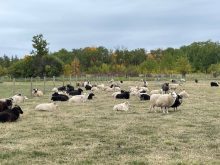Next to water, nitrogen is usually the most limiting nutrient in crop production. In prairie agriculture, by far the major source of fixed nitrogen for crop production is nitrogen produced industrially via the Haber process. But nitrogen fixation by legumes is also a very important economic factor in world agriculture.
The nitrogen-fixing family of plants, Leguminosae, number in the tens of thousands. These nitrogen-fixing legumes range in size from tiny clovers to shrubs like caragana and to full-sized trees. Our agriculturally well-known legume crops range from peas and beans to alfalfa, peanuts and soybeans.
Read Also

Claas brings 1000 Series SP forage harvesters to Canada
In mid-August, Claas unveiled its new line of Jaguar forage harvesters at an event in Visalia, California, deep in the heart of that state’s dairy region.
Nitrogen is also fixed on the prairies by free-living bacteria, fungi and different bacteria in association with common shrubs and trees like wolf willow and alder. And, you may be surprised to learn that about 15 per cent of the world supply of nitrogen comes from lightning storms in the form of nitrates.
The Haber process for manufacturing nitrogen is a sort of modified lightning storm, combining nitrogen with hydrogen to produce ammonia. The industrially fixed bagged nitrogen is no different from the five to 15 pounds of fixed nitrogen that falls on cropland per acre during a lightning storm. In reality, there is no such thing as “synthetic” nitrogen fertilizer or for that matter phosphate, potash or anything else. The term synthetic fertilizer is merely a belief, certainly not a fact.
Nitrogen fixation
Nitrogen-fixing crops of concern to prairie agriculture include alfalfa, clovers of all kinds, dry beans, faba beans, lupins, soybeans, peas, chickpeas, lentils and a few other crops. Legumes generally grow in nitrogen-poor soils, where their ability to fix nitrogen with bacteria gives them a competitive advantage over other competing crops or weeds. Adding nitrogen to a legume crop will remove that growth advantage and also inhibit the legume from forming effective nitrogen-fixing associations with the appropriate bacteria.
When I was a child in Wales in the 1950s, my father would plant red clover crops every third or fourth year. Selective weed control products were non-existent in those days so he would underseed a light crop of wheat with a clover-grass mixture after first fertilizing with phosphate and potash and some sulphate — no nitrogen. After he took off a light wheat crop in August, about 15 to 20 bushels per acre, we would get a huge growth of red clover by October. Undoubtedly, after it was plowed under at the end of the second year, there was a two- to three-year supply of nitrogen in the soil from the clover crop’s nitrogen fixation.
Nitrogen-fixing legume bacteria which we call rhizobia are characterized by their ability to infect the root hairs of legumes. These rhizobia live freely in all agricultural soils in a living active vegetative state. They do not form resting spores. These soil-dwelling rhizobia use sugars and soil acids as their sources of growth and energy. If there are wild legumes such as vetches around your farm, or stray alfalfa, they will be naturally inoculated by wild rhizobia in the soil.
Rhizobia species are generally divided into six major groups for agricultural purposes.
- Rhizobium meliloti: alfalfa and lotus types
- R. trifolii: clovers of all kinds
- R. leguminosarum: peas, faba beans, lentils
- R. phaseoli: dry beans
- R. lupini: lupins
- R. japonicum: soybeans
These rhizobial bacteria are easily propagated in laboratory culture and are generally very specific to the type of legume that they infect and nodulate. For example, Rhizobium leguminosarum can form a nitrogen-fixing partnership with peas, faba beans or lentils but not dry beans or chickpeas.
Soybeans, native to China must be inoculated with Rhizobium japonicum, which, like other rhizobia, are mixed in peat, peat pellets or liquid formulations. The soybean inoculant may not survive our Prairie winters, so to fix 60 or so pounds of additional nitrogen, soybeans may have to be inoculated every year.
On the other hand, R. leguminosarum is ever-present and adapted to Prairie soils, so if you grow peas, lentils or faba beans every few years your soil may have adequate nodulation bacteria to fix 50 to 150 pounds of “free” nitrogen. If you forget to inoculate peas, faba beans or lentils they will nodulate anyway, as you have grown them recently in that field. However, researchers have developed more specific strains of rhizobia — it’s often well worth the purchase price to have additional nitrogen fixation by these superior strains.
If you regularly grow peas or lentils you should leave a check strip with no inoculant and check the nodulation and or yield. Active nodulation is generally close to the main root and the healthy nitrogen producing nodules are a red/pink in colour when sliced open.
Effective inoculants on pulse crops or alfalfa hay can fix 50 to 200 or more pounds of nitrogen per acre. Just work out the cost savings on nitrogen fertilizer on a section of land.
Never do this with inoculant
Buying rhizobial inoculant is like buying a bunch of cut flowers. You wouldn’t leave the cut flowers in the truck cab on a sunny day, and you wouldn’t let them sit for weeks or months before bringing them into the house. Instead, you put them in a vase of cool water as soon as possible.
- NEVER leave inoculant of any kind sitting in the truck cab where the high temperature of 40+ C will quickly kill off the rhizobia.
- NEVER let the inoculant sit around for weeks or months on end before use. Store it in a cool refrigerator to keep the rhizobia alive and healthy.
- NEVER use last year’s inoculant. The rhizobial bacteria are likely all dead.
- NEVER mix inoculant with a seed treatment or micronutrient that contains zinc or copper.
- NEVER leave a liquid inoculant for many days on unplanted seed.
- NEVER skip an inoculant application if you grow soybeans on the prairies.
Remember, rhizobial inoculants are living, breathing fragile bacteria. You need to keep them fully fresh and active for best results.
















